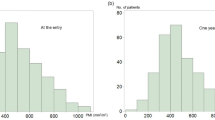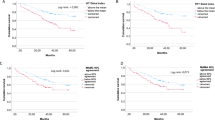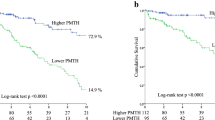Abstract
Background/Objectives:
Higher body mass index appears protective in hemodialysis patients, although it remains to be determined which component of muscle or fat mass is primarily associated with this survival advantage.
Subjects/Methods:
Eighty-one hemodialysis patients in our institution were prospectively followed from July 2011 to August 2015. Muscle and fat mass were evaluated by measuring the cross-sectional areas of the thigh and abdomen using computed tomography. The relationship between muscle and fat mass, and all-cause and cardiovascular mortality was studied using the Kaplan–Meier analyses and multivariate Cox proportional hazard models.
Results:
During more than 4 years of follow-up, 26 patients (32%) died. In the Kaplan–Meier curve analyses, lower thigh muscle mass was significantly associated with all-cause and cardiovascular mortality (log-rank test, P<0.01 and P<0.001, respectively), but there was no such association with thigh fat, abdominal muscle and fat mass levels. In multivariate Cox proportional hazard models, each 0.1 cm2/kg increase in the thigh muscle area adjusted by dry weight was associated with an estimated 22% lower risk of all-cause mortality (95% confidence interval (95% CI), 0.64–0.95, P<0.05) and a 30% lower risk of cardiovascular mortality (95% CI, 0.54–0.90, P<0.01).
Conclusions:
Lower thigh muscle mass is significantly associated with all-cause and cardiovascular mortality in hemodialysis patients. Our findings indicate the importance of focusing on the muscle mass of lower extremities to predict the clinical outcomes of hemodialysis patients.
This is a preview of subscription content, access via your institution
Access options
Subscribe to this journal
Receive 12 print issues and online access
$259.00 per year
only $21.58 per issue
Buy this article
- Purchase on Springer Link
- Instant access to full article PDF
Prices may be subject to local taxes which are calculated during checkout


Similar content being viewed by others
References
Bergstrom J . Nutrition and mortality in hemodialysis. J Am Soc Nephrol 1995; 6: 1329–1341.
Kopple JD, Zhu X, Lew NL, Lowrie EG . Body weight-for-height relationships predict mortality in maintenance hemodialysis patients. Kidney Int 1999; 56: 1136–1148.
Degoulet P, Legrain M, Reach I, Aime F, Devries C, Rojas P et al. Mortality risk factors in patients treated by chronic hemodialysis. Report of the Diaphane collaborative study. Nephron 1982; 31: 103–110.
Leavey SF, McCullough K, Hecking E, Goodkin D, Port FK, Young EW . Body mass index and mortality in 'healthier' as compared with 'sicker' haemodialysis patients: results from the Dialysis Outcomes and Practice Patterns Study (DOPPS). Nephrol Dial Transplant 2001; 16: 2386–2394.
Calle EE, Thun MJ, Petrelli JM, Rodriguez C, Heath CW Jr . Body-mass index and mortality in a prospective cohort of U.S. adults. N Engl J Med 1999; 341: 1097–1105.
Fleischmann EH, Bower JD, Salahudeen AK . Risk factor paradox in hemodialysis: better nutrition as a partial explanation. ASAIO J 2001; 47: 74–81.
Kalantar-Zadeh K, Block G, Humphreys MH, Kopple JD . Reverse epidemiology of cardiovascular risk factors in maintenance dialysis patients. Kidney Int 2003; 63: 793–808.
Beddhu S, Pappas LM, Ramkumar N, Samore M . Effects of body size and body composition on survival in hemodialysis patients. J Am Soc Nephrol 2003; 14: 2366–2372.
Caetano C, Valente A, Oliveira T, Garagarza C . Body composition and mortality predictors in hemodialysis patients. J Ren Nutr 2016; 26: 81–86.
Fukasawa H, Kaneko M, Niwa H, Matsuyama T, Yasuda H, Kumagai H et al. Circulating 20 S proteasome is independently associated with abdominal muscle mass in hemodialysis patients. PLoS One 2015; 10: e0121352.
Fukasawa H, Ishigaki S, Kinoshita-Katahashi N, Niwa H, Yasuda H, Kumagai H et al. Plasma levels of fibroblast growth factor-23 are associated with muscle mass in haemodialysis patients. Nephrology (Carlton) 2014; 19: 784–790.
Fukasawa H, Ishigaki S, Kinoshita-Katahashi N, Yasuda H, Kumagai H, Furuya R . Plasma levels of the pro-inflammatory protein S100A12 (EN-RAGE) are associated with muscle and fat mass in hemodialysis patients: a cross-sectional study. Nutr J 2014; 13: 48.
Kaizu Y, Ohkawa S, Kumagai H . Muscle mass index in haemodialysis patients: a comparison of indices obtained by routine clinical examinations. Nephrol Dial Transplant 2002; 17: 442–448.
Ohkawa S, Kaizu Y, Odamaki M, Ikegaya N, Hibi I, Miyaji K et al. Optimum dietary protein requirement in nondiabetic maintenance hemodialysis patients. Am J Kidney Dis 2004; 43: 454–463.
Ochi M, Kohara K, Tabara Y, Kido T, Uetani E, Ochi N et al. Arterial stiffness is associated with low thigh muscle mass in middle-aged to elderly men. Atherosclerosis 2010; 212: 327–332.
KDOQI . KDOQI clinical practice guidelines and clinical practice recommendations for diabetes and chronic kidney disease. Am J Kidney Dis 2007; 49: S12–154.
Walther CP, Carter CW, Low CL, Williams P, Rifkin DE, Steiner RW et al. Interdialytic creatinine change versus predialysis creatinine as indicators of nutritional status in maintenance hemodialysis. Nephrol Dial Transplant 2012; 27: 771–776.
Park J, Mehrotra R, Rhee CM, Molnar MZ, Lukowsky LR, Patel SS et al. Serum creatinine level, a surrogate of muscle mass, predicts mortality in peritoneal dialysis patients. Nephrol Dial Transplant 2013; 28: 2146–2155.
Carrero JJ, Chmielewski M, Axelsson J, Snaedal S, Heimburger O, Barany P et al. Muscle atrophy, inflammation and clinical outcome in incident and prevalent dialysis patients. Clin Nutr 2008; 27: 557–564.
Kalantar-Zadeh K, Kuwae N, Wu DY, Shantouf RS, Fouque D, Anker SD et al. Associations of body fat and its changes over time with quality of life and prospective mortality in hemodialysis patients. Am J Clin Nutr 2006; 83: 202–210.
Kakiya R, Shoji T, Tsujimoto Y, Tatsumi N, Hatsuda S, Shinohara K et al. Body fat mass and lean mass as predictors of survival in hemodialysis patients. Kidney Int 2006; 70: 549–556.
Rockwood K, Song X, MacKnight C, Bergman H, Hogan DB, McDowell I et al. A global clinical measure of fitness and frailty in elderly people. CMAJ 2005; 173: 489–495.
Wolfe RR . The underappreciated role of muscle in health and disease. Am J Clin Nutr 2006; 84: 475–482.
Roshanravan B, Robinson-Cohen C, Patel KV, Ayers E, Littman AJ, de Boer IH et al. Association between physical performance and all-cause mortality in CKD. J Am Soc Nephrol 2013; 24: 822–830.
Hida T, Ishiguro N, Shimokata H, Sakai Y, Matsui Y, Takemura M et al. High prevalence of sarcopenia and reduced leg muscle mass in Japanese patients immediately after a hip fracture. Geriatr Gerontol Int 2013; 13: 413–420.
Isoyama N, Qureshi AR, Avesani CM, Lindholm B, Barany P, Heimburger O et al. Comparative associations of muscle mass and muscle strength with mortality in dialysis patients. Clin J Am Soc Nephrol 2014; 9: 1720–1728.
Kato A, Ishida J, Endo Y, Takita T, Furuhashi M, Maruyama Y et al. Association of abdominal visceral adiposity and thigh sarcopenia with changes of arteriosclerosis in haemodialysis patients. Nephrol Dial Transplant 2011; 26: 1967–1976.
Carnagarin R, Dharmarajan AM, Dass CR . Molecular aspects of glucose homeostasis in skeletal muscle - a focus on the molecular mechanisms of insulin resistance. Mol Cell Endocrinol 2015; 417: 52–62.
Srikanthan P, Karlamangla AS . Relative muscle mass is inversely associated with insulin resistance and prediabetes. Findings from the third National Health and Nutrition Examination Survey. J Clin Endocrinol Metab 2011; 96: 2898–2903.
Srikanthan P, Karlamangla AS . Muscle mass index as a predictor of longevity in older adults. Am J Med 2014; 127: 547–553.
Koppe L, Pelletier CC, Alix PM, Kalbacher E, Fouque D, Soulage CO et al. Insulin resistance in chronic kidney disease: new lessons from experimental models. Nephrol Dial Transplant 2014; 29: 1666–1674.
Mitch WE, Goldberg AL . Mechanisms of muscle wasting. The role of the ubiquitin-proteasome pathway. N Engl J Med 1996; 335: 1897–1905.
Fukasawa H . The role of the ubiquitin-proteasome system in kidney diseases. Clin Exp Nephrol 2012; 16: 507–517.
Cheema B, Abas H, Smith B, O'Sullivan AJ, Chan M, Patwardhan A et al. Investigation of skeletal muscle quantity and quality in end-stage renal disease. Nephrology (Carlton) 2010; 15: 454–463.
Tuttle LJ, Sinacore DR, Cade WT, Mueller MJ . Lower physical activity is associated with higher intermuscular adipose tissue in people with type 2 diabetes and peripheral neuropathy. Phys Ther 2011; 91: 923–930.
Acknowledgements
We thank Dr Kazuhiro Saisu (Juzen hospital, Hamamatsu, Japan) for providing the clinical advice and information. This work was supported by grants from The Kidney Foundation, Japan (JKFB 15–19).
Author contributions
HF, HY, HK and RF designed the study. MK, HN and TM were involved in the data acquisition. HF, HK and RF carried out the statistical analysis and drafted the manuscript. All authors read, revised and approved the final version of manuscript.
Author information
Authors and Affiliations
Corresponding author
Ethics declarations
Competing interests
The authors declare no conflict of interest.
Rights and permissions
About this article
Cite this article
Fukasawa, H., Kaneko, M., Niwa, H. et al. Lower thigh muscle mass is associated with all-cause and cardiovascular mortality in elderly hemodialysis patients. Eur J Clin Nutr 71, 64–69 (2017). https://doi.org/10.1038/ejcn.2016.186
Received:
Revised:
Accepted:
Published:
Issue Date:
DOI: https://doi.org/10.1038/ejcn.2016.186
This article is cited by
-
Concordance between muscle mass assessed by bioelectrical impedance analysis and by muscle ultrasound: a cross-sectional study in a cohort of patients on chronic hemodialysis
BMC Nephrology (2024)
-
Ultrasound quadriceps muscle thickness is variably associated with frailty in haemodialysis recipients
BMC Nephrology (2023)
-
Quadriceps muscle thickness assessed by ultrasound is independently associated with mortality in hemodialysis patients
European Journal of Clinical Nutrition (2022)
-
Low skeletal muscle mass by computerized tomography is associated with increased mortality risk in end-stage kidney disease patients on hemodialysis
Journal of Nephrology (2022)
-
Six-minute walk distance predicts hospitalization in elderly peritoneal dialysis patients: a single-center prospective cohort study
Renal Replacement Therapy (2021)



